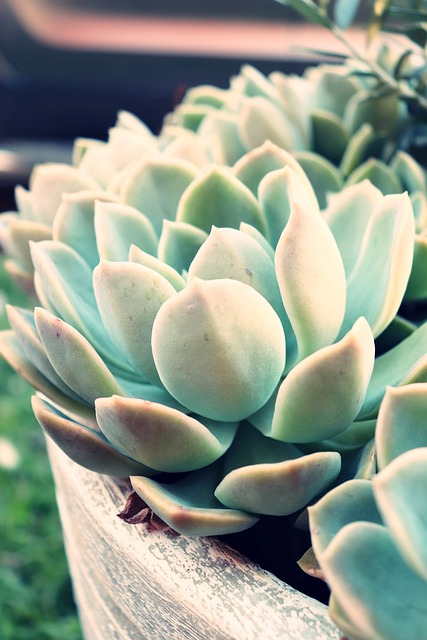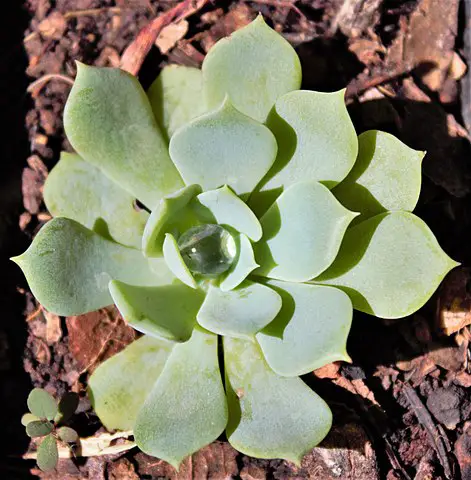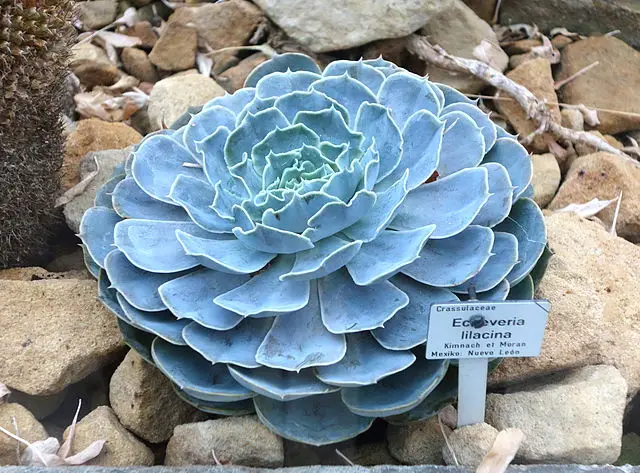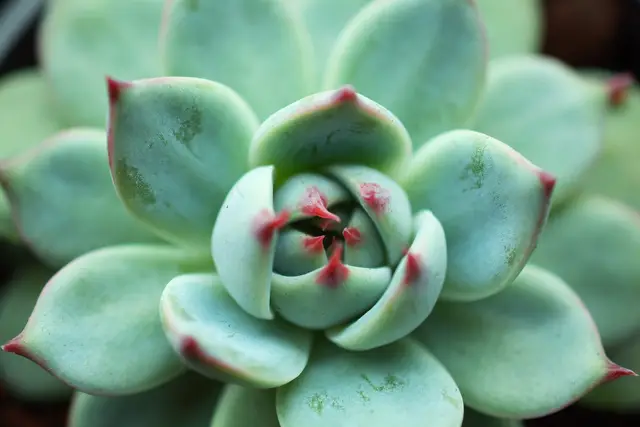Echeveria elegans, or the Mexican snowball plant, is one of the most popular succulents and is an easy plant for novice succulent growers. Mexican snowball forms compact rosettes and has full, oval shaped leaves which store water during dry periods. Mexican snowball can actually change colour under varying light levels, turning from having regular green leaves to blue leaves with pink tips in areas of high light. It forms a strong root system during these drought period and responds well to deep but intense watering sporadically in a way which allows the soil to dry out in between watering in order to enable this root growth.
Echeveria elegans starts off small but can grow to much larger sizes given the right conditions. With sufficient attention it even grows flower spikes with attractive peach and orange flowers. With these qualities, it is an appealing succulent which can survive in a variety of conditions providing the correct requirements are met and can be grown in different locations depending on what is required.
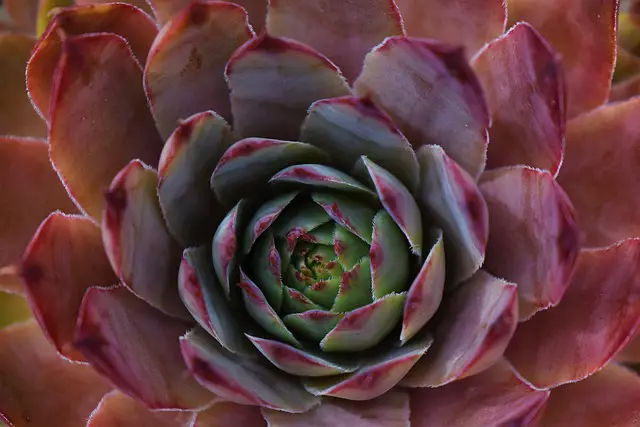
As it grows, Mexican snowball will form clusters or mounds of separate rosettes with their own stems. Alternatively an individual rosette can grow and expand by itself until it is large enough to put out flower spikes. During growth, echeveria elegans is heavily dependent on the weather and seasons. For example, its colour changing abilities are also dependent on the cold and when it is colder the edges of the leaves turn pink and the leaves themselves are blue. In addition, the plant clumps up during the winter and spreads its leaves out flat during the summer, which is its growing season. In autumn, it displays its clumping habit as this is the period of offset formation and can form significant numbers of offsets per year.
Growing Echeveria Elegans from Seed
Mexican snowball can be grown from seed. These seeds are extremely fine and can often look like dust or be confused with the surrounding soil. When grown from seed, Mexican snowball first sends up tiny shoots which eventually fan out into rosettes resembling the larger adult plant. They then grow at their own pace until they are mature enough to reproduce, grow flowers, and drop seeds of their own.
At many stages during their growth, Mexican snowball plants may naturally drop leaves. These may then take root depending on when and where they fall, growing again into miniature versions of the adult plant. This is a mechanism of the plant so that in times of hardship it is able to continue its growth through its offspring.
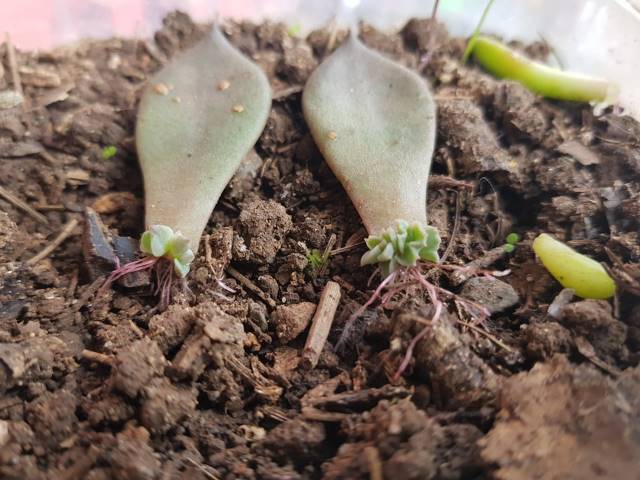
Propagating Echeveria Elegans in captivity means taking advantage of this natural process in order to grow new plants from leaf. Propagation is one of the methods alongside growing from seed which can be used to cultivate Mexican snowball at home.
Planting Mexican Snowball
Mexican snowball can be companion planted with other members of the echeveria genus or alternatively with other plants which also enjoy its mountain habitat. These include aloes as well as other members of the crassula family which also live in the mountain crevices in which echeveria elegans chooses to dwell. It can be planted outside if your climate is warm enough – although be warned that it does not necessarily enjoy the maximum aridity that you would stereotypically expect from a succulent. It also does not do well in frost nor does it enjoy being waterlogged, which means that if your area is prone to rain it may be better to keep echeveria elegans indoors.
Planting in a pot and keeping in a well-lit space which gets preferable eight or more hours per day of direct sunlight is the ideal way to keep it healthy. One of the worst places to keep a Mexican snowball plant is in a bathroom as the humidity is too high and the room is one of the ones which often does not get consistent daylight. If you choose to keep the plant indoors it is sometimes beneficial to move it from one place to another in order to ensure it gets the correct conditions in the correct amounts. Due to its mountainous habitat, Mexican snowball can often benefit from a fluctuation in temperature in order for it to properly reach equilibrium in its growth patterns.
Best Types of Pots for Mexican Snowball
Mexican snowball can be grown in a variety of conditions and different containers are part of this. As a result, it is possible to plant it in aesthetically pleasing situations alongside other succulents and mountain-dwelling plants. It is most conventionally grown in small pots by itself as an office plant or houseplant – but can actually be grown in planters and other creative situations such as in miniature indoor gardens and even outside, providing conditions are dry and warm enough. As mentioned above, the one place where Mexican snowball should not be grown is in a bathroom, due to the lack of light and high humidity received by these rooms. Pots must have sufficient drainage due to Mexican snowball naturally having fast draining soil in the wild.
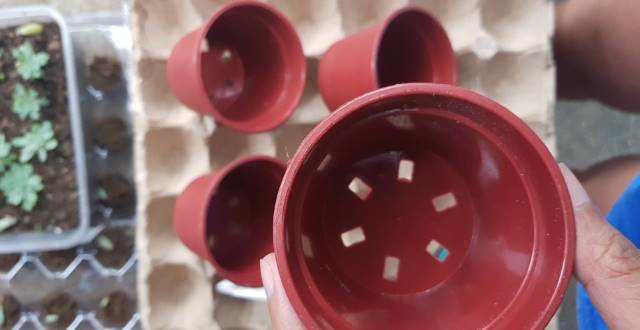
One way of achieving this is by placing a tray or plate under the pot if it has a hole in the bottom, so water can quickly filter through. Another way is filling the bottom of the pot with medium sized stones so that water can drain away and fill the space underneath where it will gradually evaporate. Pots should be sufficiently roomy for your Mexican snowball to grow strong roots during the dry periods between watering. This increases its resistance to pests and disease and ensures it can survive if conditions ever drop below the optimum.
Types of Soil
You may often hear about specialist cactus and succulent soil, and whilst this can be useful for beginner growers due to its ease of use, it is always ideal to consider more species or environment specific soils for your succulents so that they may reach optimum growth. Cactus and succulent soil is intended for a wide range of plants which may grow anywhere from full desert conditions to montane forests and alpine habitats. Therefore a specific soil for echeveria elegans would take into account the fact that it grows in fast draining soils but without the full aridity of a desert climate – and therefore too much sand in the soil could ultimately harm it.
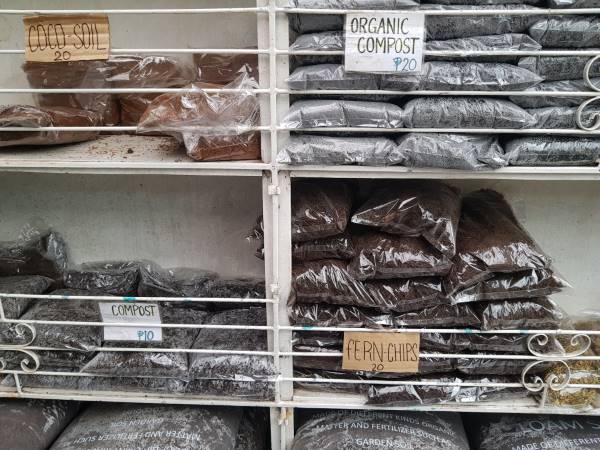
Mixing in perlite, a naturally occurring volcanic glass, can help water absorption and means that the duration of time in between watering can be increased. It also provides a good intermediary between sand and regular soil. Therefore a custom soil can be made for echeveria elegans with sand, perlite, specialist cactus and succulent soil, and some regular soil. Experimenting with different combinations can ensure you get to know your Mexican snowball’s requirements in tandem with how it interacts with the surrounding environment.
Pruning Mexican Snowball
Like most succulents, Mexican snowball does not need a large amount of pruning and the only instances in which it may need to be heavily pruned would be if it has become etiolated. Etiolation is a state when the plant has stretched its stem and its compact rosette shape – its natural growth habit – is no longer intact. This happens in response to lack of light as the succulent stretches and grows towards the little light which is available. In these circumstances, relatively heavy pruning is encouraged. This can be done by cutting off the non-etiolated top part of the stem and replanting it so that it may grow new roots. The remainder of the plant can be leaf propagated in order to get as much new growth out of the plant as possible.
Apart from this, the only pruning which is necessary is the occasional removal of dead leaves and flowers, which may occur as a result of the plant drying out during the periods in between watering – or as a natural part of its flowering and growth process.
When pruning, using sharp scissors or garden shears which have been rinsed in hot water can help prevent the spread of diseases and keep your succulents healthy.
Mexican Snowball – Encouraging Flowering
To encourage flowering of Mexican snowball, optimum conditions are needed, but beyond this it can be fertilised slightly to ensure it has the full amount of nutrients needed to grow. In its natural mountain habitat, Mexican snowball grows alongside many other plants in an ecosystem where new organic matter is constantly added to the soil, so as a result when grown indoors in isolation, some of these nutrients may be missing.
However, be careful not to over fertilize or use the wrong fertilizer – natural fertilizers are good, but check they are appropriate for the plant’s environment and are cactus and succulent specific, as Mexican snowball has specific nutrient requirements which differ from plants which grow in more fertile soils. Fertilizer should be more dilute and used less often than for non-succulent plants. Again, over fertilizing can stress this plant out, so it is important to consider this in your watering regime, and include fertilizing with watering to avoid the inevitable problems which come with over-watering succulents.

Flowering takes place in the summer – the plant’s growing season – and the first signs involve the plant sending up a long spike on which its flowers eventually grow. Echeveria elegans is semi-dormant during winter and may need warmer conditions then, especially if you live in a colder climate so that they do not shut down their energy processes completely. Flowering can be encouraged by increasing the temperature to mimic a semi-arid environment, and ensuring light is available for a long enough duration. Mexican snowball is used to a drop in temperature at night; including this while it is flowering can help align its natural processes. This can be done by keeping the lights off at night and moving it to a colder room.
Variations
Mexican snowball is a naturally variable plant, and can even change colour based on the amount of light it receives. In high light levels it develops a pink edge to its leaves. Unlike some species of succulent, Mexican snowball and all its variations can be considered the same species; resultantly this plant does not have any subspecies. This is because while there may be some variations in leaf shape or colour, and occasionally in growth habit, they are ultimately minor enough that they can be considered the same species.
Mexican Snowball – Pests and Diseases
Like most succulents, echeveria elegans is a hardy plant and if kept in the correct conditions does not see any pests or diseases. Nevertheless, over or underwatering – or too much aridity – can make Mexican more prone to attack from pests. Some of the most common pests are spider mites, mealybugs, vine weevils and aphids. These can be unpleasant but are generally easily managed and once the plant recovers correct conditions will prevent them reappearing.
Fungus gnats can be found on the surface of the soil and look like tiny black flies. They are most damaging when propagating Mexican snowball because they harm small seedlings and developing plants. Keeping seedlings in correct conditions prevents them, but this can also be done by letting them dry sufficiently between watering as the most common cause of fungus gnats is overwatering. The larvae – as opposed to the adult flies – do the most damage as they eat the roots of the developing plants, which is especially difficult for seedlings which are only just in the process of growing them.
As opposed to eating the roots, mealybugs eat the leaves of plants. Like fungus gnats, they generally become a problem when the plant has been overwatered or over fertilised. With all succulent pests, it is important to recognise that pest attack does not exist in isolation and instead happens when the plant is weakened by other factors or kept in the incorrect conditions. Spider mites can be spotted by the fact that your plant will be covered in small brown dots and fine white webbing. These pests suck the juices from plants and damage the undersides of their leaves. Of these pests, mealybugs are the largest, but on echeveria elegans may be difficult to spot due to the fact that they cluster around the shem and may therefore be hidden by the leaves.
Mexican Snowball in the Wild
It may be that beyond simply keeping Mexican snowball as a succulent, you wish to recreate its natural conditions in the wild. In this case, some setup is needed as Mexican snowball grows in mountainous conditions and is often found in tandem with other plants. As a result, micro habitats can be created in a single planter – for example, planting Mexican snowball alongside aloes creates similar conditions to what it experiences naturally.
The grows with share similar conditions, so for both echeveria elegans and aloes or other members of the crassula family a combination of sand, perlite, and regular but dry soil can be used to recreate their fast draining soils. In fact, perlite – a volcanic rock notable for holding water and expanding with temperature – can actually mean that succulents have to be watered less often than would be needed. If you use perlite in your soil mixture, be sure to take note of this and the differing water requirements of any plants which you grow together.
Plants which do not necessarily come from the same habit as echeveria elegans can still nevertheless be grown alongside it. For a planter with different levels, try echeveria elegans with an aloe and a trailing succulent such as burro’s tail or string of hearts. The good thing about this is due to their different growth habits, these plants are tolerant of different levels of shade and therefore their growth interacts with each other, the more shade loving plants being sheltered by the taller ones. In fact, though echeveria elegans enjoys high levels of light in the wild, this is its natural growth habit and when growing succulents it is always important to consider the plant as part of an ecosystem as a whole, as opposed to just a species in isolation which improves the look of a room.
Conclusion
In conclusion, echeveria elegans is a versatile and easy to care for succulent which thrives in a variety of situations providing its requirements are understood from all perspectives. For a novice plant grower, it can sometimes be daunting to absorb all information out there about a plants habitat – and often there is conflicting information based on individuals’ experiences with a given plant. By understanding everything about echeveria elegans or the Mexican snowball plant, you can ensure it has the optimum conditions and gets everything it needs regardless of how you wish to grow it – alone or separately, in a pot, companion planter, office, or by a brightly lit windowsill. As a beginner friendly succulent, learning about its propagation, growth habits, flowering, and requirements can give you the skills needed for more difficult to look after succulents.

